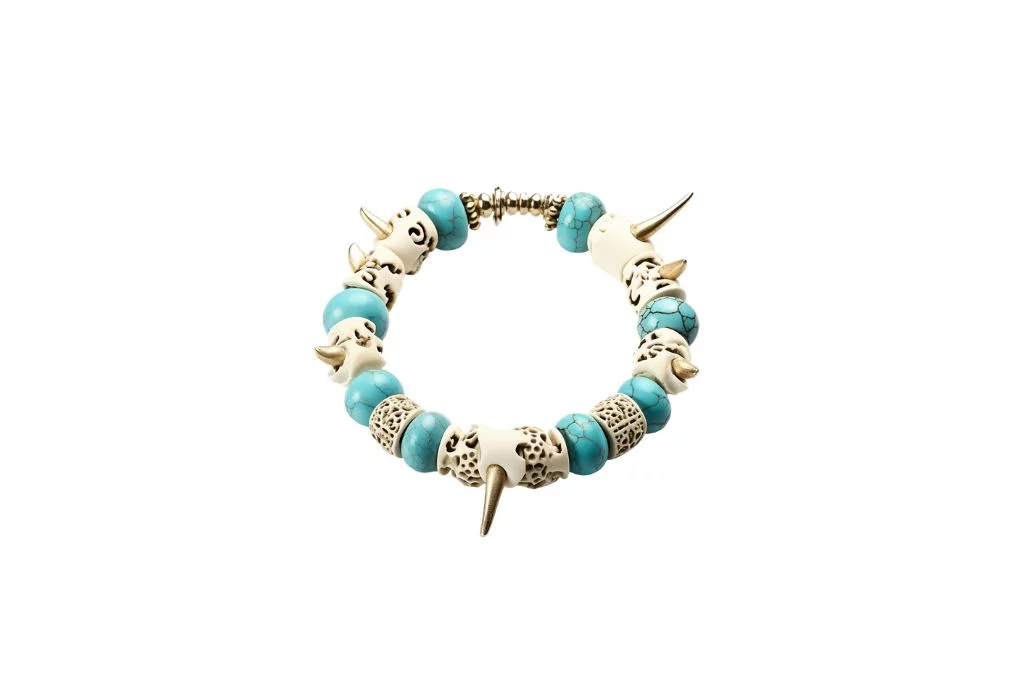Color and Appearance of Bone Turquoise
Bone turquoise, despite its name, is not actually turquoise at all. It is a man-made material created by infusing bone with blue dye to mimic the appearance of genuine turquoise. The color of bone turquoise typically ranges from light sky blue to a deeper, more vibrant turquoise hue. The intensity of the color can vary depending on the dyeing process and the quality of the bone used.
Structure and Composition
The structure of bone turquoise is quite distinct from natural turquoise. It retains the porous nature of bone, which gives it a unique texture and appearance. The material is often characterized by tiny holes and crevices throughout its surface, creating a somewhat spongy or coral-like texture. This porous structure is what allows the dye to penetrate the bone material, resulting in its distinctive coloration.
Notable Physical Characteristics
One of the most notable physical characteristics of bone turquoise is its lightweight nature. Compared to genuine turquoise, which is a dense mineral, bone turquoise feels significantly lighter. This property makes it popular for use in large jewelry pieces that might otherwise be too heavy if made with natural turquoise. Additionally, bone turquoise often exhibits a subtle sheen or luster that can vary from matte to slightly glossy, depending on how it has been treated and polished.
Unique Aspects and Features
What makes bone turquoise stand out is its ability to be carved into intricate shapes and designs. The softness of the bone material allows for detailed carving work that would be difficult to achieve with natural turquoise. This characteristic makes bone turquoise particularly popular for elaborate beads, pendants, and decorative objects. Furthermore, the material can sometimes retain subtle hints of its organic origin, with occasional variations in color or texture that add to its unique aesthetic appeal.
Historical and Cultural Significance of Bone Turquoise
Bone turquoise, also known as fossil turquoise, has been prized for centuries by various cultures, particularly Native American tribes. This unique material forms when prehistoric animal bones or teeth absorb minerals from surrounding turquoise deposits, creating a striking blue-green color with a distinctive organic pattern. The Ancestral Puebloans and other indigenous groups of the American Southwest used bone turquoise in jewelry, ceremonial objects, and sacred artifacts, believing it to possess powerful spiritual properties.
Metaphysical Associations
In metaphysical circles, bone turquoise is believed to combine the grounding energies of fossilized bone with the healing properties of turquoise. It is thought to promote a connection between the physical and spiritual realms, facilitating communication with ancestral spirits and enhancing intuition. Many practitioners associate bone turquoise with protection, purification, and the alignment of the chakras, particularly the throat chakra.
Common Uses and Benefits
Today, bone turquoise is primarily used in jewelry making, where its unique patterns and colors make for striking pendants, earrings, and beads. It is also incorporated into various holistic healing practices, such as crystal therapy and energy work. Some believe that wearing or meditating with bone turquoise can help balance emotions, boost confidence, and promote overall well-being. In alternative medicine, it is sometimes used to support bone health and aid in the treatment of respiratory issues.
Modern Applications
In recent years, bone turquoise has gained popularity among collectors and artisans who appreciate its rarity and distinctive appearance. It is often featured in high-end jewelry designs that blend traditional Native American aesthetics with contemporary styles. Some modern practitioners use bone turquoise in rituals aimed at connecting with ancestral wisdom or facilitating past-life recall. Its believed ability to bridge the gap between ancient knowledge and modern consciousness makes it a sought-after tool for spiritual growth and personal development.

